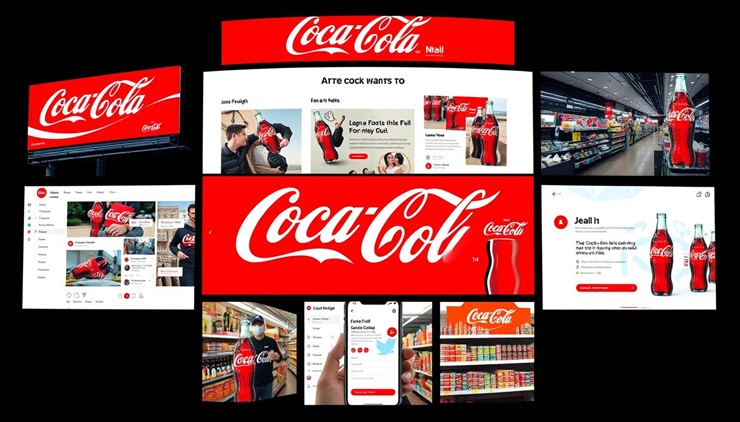Understanding the Scope of Marketing: Key Areas, Trends, and Strategies

Author: Siva Prakash
Marketing is more than just ads or sales. It's about understanding what people want and building strong relationships online. In today's fast-paced world, knowing marketing well is key for growth and connecting with customers. Marketing has changed a lot over time. It's now about research, strategy, digital engagement, and using data. This guide will show you how to use marketing to succeed in today's market.

Key Components of the Scope of Marketing
Marketing has many parts that work together. Knowing each part helps businesses create better marketing plans. These plans are made for specific goals and the people they want to reach. The interconnected components within the scope of marketing
Market Research and Analysis
Good marketing starts with solid research. This means studying your market, competitors, and trends. Research helps make smart business choices and strategies that people like.
- Consumer behavior analysis to understand purchasing patterns and preferences
- Competitor analysis to identify market gaps and opportunities
- Industry trend monitoring to stay ahead of market shifts
- Customer feedback collection to improve products and services
Studies show companies that research often do better than those that don't. They are 63% more likely to beat their competitors.
Market Segmentation and Targeting
Marketing also means finding the right groups of customers and tailoring your message to them. Good segmentation helps use resources wisely and speak to different groups in a way that matters.
Segmentation Types
- Demographic: Age, gender, income, education
- Geographic: Location, climate, urban/rural
- Psychographic: Lifestyle, values, attitudes
- Behavioral: Usage patterns, loyalty, benefits sought
Targeting Strategies
- Concentrated: Focus on a single segment
- Differentiated: Target multiple segments with unique approaches
- Undifferentiated: Mass marketing to all segments
- Micromarketing: Highly personalized targeting
Product Development and Management
Product development is key in marketing. It makes sure products meet market needs and customer wants. This means creating, changing, and managing products to stay relevant and competitive. Good product marketing needs teamwork between marketing, R&D, and sales. It involves testing ideas, making prototypes, testing in the market, and improving based on feedback. The product development cycle within the marketing scope
Brand Management and Positioning
Brand management is vital in marketing. It's about building and keeping a strong brand image. This includes setting brand rules, managing how people see your brand, and keeping it consistent everywhere. Good brand positioning makes your business stand out. It's about defining your brand's values, personality, and promise. This creates emotional bonds with your audience.
Need help defining your brand position?
Our marketing experts can craft a strong brand strategy. It will connect with your audience and set you apart.
Digital Marketing Channels
The digital world has changed marketing a lot. Now, marketers use many online channels to reach people. They need to know how to use these channels well.
Search Engine Optimization (SEO) - SEO helps your website show up higher in search results. This brings more people to your site.
Social Media Marketing - Social media helps build your brand. You can talk to customers on sites like Facebook and Twitter.
Content Marketing - Content marketing attracts and keeps an audience. It helps drive action that makes money.
Email Marketing - Emails help keep in touch with customers. You can send them personalized messages.
Pay-Per-Click Advertising - PPC ads bring people to your site right away. They work on search engines and social media.
Influencer Marketing - Influencer marketing uses famous people to promote your products. They talk to their followers about what you offer.
Customer Relationship Management (CRM)
Marketing is not just about selling. It's also about keeping customers happy over time. CRM helps with this. CRM uses customer data to make interactions better. It helps businesses keep customers happy and loyal. The customer relationship management cycle
The Evolution of Marketing Scope
Marketing has changed a lot over the years. It used to just be about promoting products. Now, it's about using data to understand customers.
From Traditional to Digital Marketing
Old marketing methods like print and TV are now joined by digital ones. This change has brought new skills and ways to market.
| Era | Primary Focus | Key Channels | Marketing Approach |
|---|---|---|---|
| 1950s-1970s | Product-centric | Print, radio, television | Mass marketing, one-way communication |
| 1980s-1990s | Customer-centric | Direct mail, telemarketing, early internet | Segmentation, relationship marketing |
| 2000s-2010s | Digital transformation | Websites, email, social media | Content marketing, engagement |
| 2010s-Present | Data-driven personalization | Mobile, social media, video platforms | Omnichannel, AI-powered personalization |
The Rise of Data Analytics and Automation
Today, marketing uses data to understand customers. This has made marketing more complex but also more effective. Automation tools have changed how we talk to customers. They help us send personalized messages without spending too much time on it.
Struggling with marketing automation?
We can help you use automation to save time and give better customer experiences.
Global vs. Local Marketing Scope
Marketing is different for global and local businesses. Each has its own challenges and chances. Marketers need to know how to handle these differences.
Challenges in International Marketing
Global marketing faces many hurdles, like cultural differences and language barriers. What works in one place might not work in another. This makes it key to tailor marketing for each area.
Global Marketing Advantages
- Expanded market reach and revenue
- Economies of scale in production and marketing
- Brand recognition across markets
- Diversified risk across different economies
Global Marketing Challenges
- Cultural and language barriers
- Complex regulatory compliance
- Varied consumer preferences and behaviors
- Logistical and operational complexities
Hyper-Local Marketing Strategies
Hyper-local marketing targets specific areas with tailored messages. It's popular because people value authenticity and community. This approach often leads to better results than broad strategies. Effective hyper-local marketing uses location data and local partnerships. It creates experiences that matter to customers in specific areas. This can lead to higher engagement and sales.
Challenges in Modern Marketing Scope
Marketing is getting bigger, and marketers face many challenges. They need to be adaptable, creative, and tech-savvy to succeed.
Privacy Concerns and Data Regulations
Marketers must balance personalization with privacy rules like GDPR and CCPA. This has made data collection and use more complex. Now, they need to be more open and get consent. The loss of third-party cookies has changed how marketers track and target. They're now using first-party data, contextual ads, and privacy tech more.
Key Privacy Considerations: Get clear consent, have good privacy policies, use less data, keep it safe, and respect user choices.
Adapting to Algorithm Changes
Social media and search engines change their algorithms often. This affects how content is seen and found. Marketers need to keep up and adjust their plans to stay effective. Instead of relying on one channel, successful marketers use many. They focus on making valuable content that works well, no matter the algorithm changes.
Case Study: Mastering the Scope of Marketing
Coca-Cola shows how understanding marketing can lead to success. They use research, segment their audience, keep their brand message consistent, and innovate digitally.
Coca-Cola: A Holistic Marketing Approach
Coca-Cola uses the full scope of marketing to stay on top. They focus on emotions, keep their brand look consistent, adapt to local markets, and embrace digital.

Key Success Factors:
- Emotional branding: Focuses on happiness and shared moments
- Consistent visual identity: Refreshes campaigns while keeping recognizable
- Localized global strategy: Adapts messaging for cultures while keeping core values
- Omnichannel presence: Offers seamless experiences across all touchpoints
- Content marketing excellence: Creates shareable content that supports brand values
Coca-Cola maintains consistent branding across diverse marketing channels. The Coca-Cola example shows how using all parts of marketing creates a strong strategy.
Future Trends in the Scope of Marketing
Marketing is always changing with new tech and shifting consumer habits. Marketers should be ready for these trends to stay ahead.
Personalization at Scale
Advanced AI and machine learning are changing personalization. Marketers can now tailor experiences for thousands or millions of people at once. This makes interactions more relevant and engaging. The future of personalization is more than just using names. It includes content and product suggestions based on what each person likes and does. Even prices can be personalized.
Voice Search Optimization
Voice assistants are getting more common. This makes optimizing for voice search key for marketers. They need to understand how people talk and ask questions. Voice search optimization is about answering questions and using conversational keywords. It's also about creating content that meets users' immediate needs. Local businesses benefit a lot from this.
Sustainability in Marketing
Being green is now a must for businesses. More people want to support brands that care about the environment and ethics. Good sustainability marketing is about being real. It means showing how you're making a difference and telling true stories. Brands that care about the planet build stronger connections with their customers.
Ready to future-proof your marketing strategy?
Our marketing consultants can guide you in using new trends and tech. This will help you stay ahead.
Conclusion
Marketing has grown a lot in recent years. It's now about more than just promoting products. It's about research, strategy, digital engagement, and building relationships. Good marketing combines many parts. It includes market research, segmentation, brand management, and digital strategy. This approach meets customer needs at every step. By embracing marketing fully, businesses can build strong brands and keep customers loyal.
Frequently Asked Questions About the Scope of Marketing
What is included in the scope of marketing?
The scope of marketing includes many things. It's about understanding what customers need and delivering value. This includes market research, segmentation, product development, pricing, distribution, promotion, brand management, digital marketing, and customer relationship management.
How has digital transformation affected the scope of marketing?
Digital transformation has changed marketing a lot. It's now about new channels, technologies, and strategies. Marketers need skills in SEO, social media, content marketing, email automation, and data analytics. The digital world also lets us target and personalize better.
What's the difference between marketing and advertising?
Advertising is just a part of marketing. It's about promoting products or services through paid channels. Marketing is the whole process of understanding customer needs, developing products, pricing, distributing, and building relationships.
How important is social media within the scope of marketing?
Social media is very important in marketing. It helps with brand awareness, engagement, content distribution, and sales. But, its role depends on the industry and audience. A good marketing strategy should use social media as part of a mix of channels and tactics.

